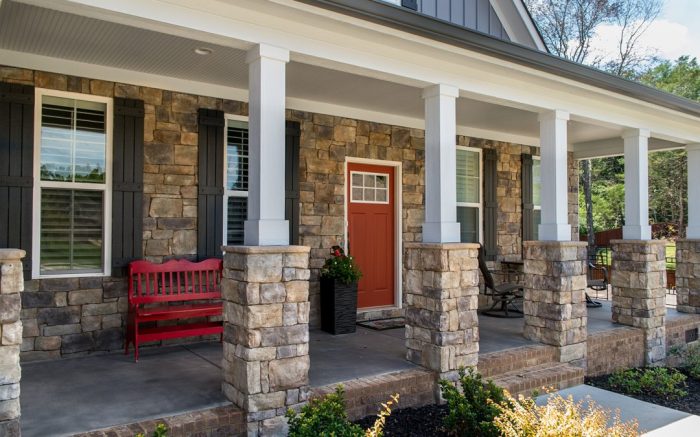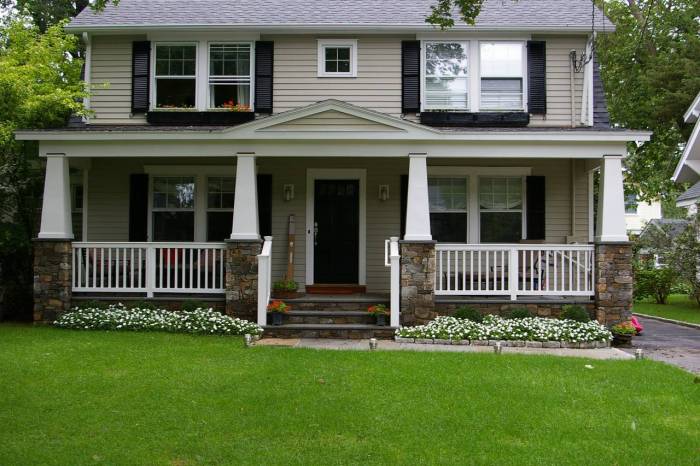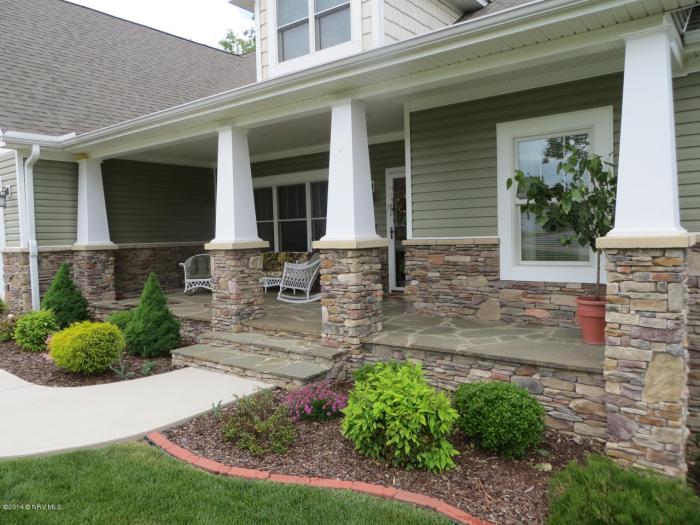Step onto the stately front porch, where stone pillars stand as majestic guardians, framing the entrance to your abode. These architectural wonders are not mere structural supports but rather expressions of timeless elegance and enduring charm. Join us as we delve into the world of front porches with stone pillars, exploring their design, materials, structural integrity, decorative elements, landscaping, and cost considerations.
Prepare to be inspired as we unveil the secrets of these architectural gems.
From classic Colonial to modern Farmhouse, stone pillars seamlessly blend with diverse architectural styles, adding a touch of sophistication and grandeur to any home. Their shapes and sizes vary, from stately cylindrical columns to graceful tapered pillars, each enhancing the aesthetics of the front porch in its unique way.
The placement and spacing of these pillars are not mere afterthoughts but rather carefully considered elements that contribute to both visual appeal and functionality.
Design Considerations
Incorporating stone pillars into a front porch design offers a classic and sophisticated touch. To ensure a harmonious aesthetic, careful consideration should be given to the architectural style of the home, the shape and size of the pillars, and their placement.
For traditional homes, such as Georgian or Colonial, stone pillars with square or rectangular bases and fluted or smooth shafts complement the symmetrical and formal lines of the architecture. Tuscan-style pillars, characterized by their sturdy cylindrical shape and simple moldings, are a suitable choice for rustic or Mediterranean-inspired homes.
Round or octagonal pillars with decorative capitals can add a touch of elegance to Victorian or Craftsman-style porches.
Pillar Shape and Size
The shape and size of the stone pillars should be proportionate to the scale of the porch. Taller and wider pillars are appropriate for larger porches, while smaller and narrower pillars are better suited for smaller spaces. Pillars should be spaced evenly apart, typically 6-8 feet, to provide both visual appeal and structural support.
Material Selection
Choosing the right stone material for your front porch pillars is crucial for durability, aesthetics, and maintenance.
Stone Types and Properties
- Limestone: Soft and porous, limestone is prone to staining and weathering. However, it is affordable and easy to carve, making it a popular choice for decorative pillars.
- Sandstone: Similar to limestone, sandstone is relatively soft and porous, but it offers a wider range of colors and textures.
- Granite: A hard and durable stone, granite is resistant to weathering and staining. It is more expensive than limestone or sandstone but provides excellent longevity.
- Travertine: A natural stone with a porous surface and unique veining, travertine is commonly used for its rustic and elegant appearance.
Color and Texture Considerations
The color and texture of your stone pillars should complement the overall style of your home and landscaping.
- Light-colored stones: Such as limestone or travertine, reflect light and create a more open and inviting space.
- Dark-colored stones: Like granite or sandstone, provide a more dramatic and formal look.
- Smooth-textured stones: Offer a classic and elegant appearance.
- Rough-textured stones: Add visual interest and create a more rustic or natural aesthetic.
Durability and Maintenance
The durability of stone pillars depends on the type of stone and the environmental conditions. Granite and travertine are highly durable and require minimal maintenance. Limestone and sandstone are less durable and may require regular cleaning and sealing to prevent staining and weathering.
Structural Integrity
Designing stone pillar supports for front porches requires careful consideration of engineering principles to ensure their stability and longevity. This involves understanding the forces acting on the pillars and designing the foundation and reinforcement techniques accordingly.
The weight of the porch roof, the weight of the stone pillars themselves, and any additional loads, such as snow or wind, must be taken into account when designing the foundation. The foundation should be deep enough to reach stable soil and wide enough to distribute the load evenly.
The type of soil and the depth of the frost line in the area will also influence the foundation design.
Foundation Requirements
The foundation for stone pillar supports should be constructed of concrete or reinforced concrete and extend below the frost line. The depth of the foundation will depend on the soil conditions and the weight of the porch. The foundation should be wide enough to distribute the load evenly and prevent the pillars from sinking or settling.
Reinforcement Techniques
Stone pillars can be reinforced with steel rods or rebar to increase their strength and prevent cracking or damage. The steel rods are embedded in the stone during construction and help to resist bending and shear forces. Reinforcing the pillars is especially important in areas with high wind loads or seismic activity.
Decorative Elements
Stone pillars on front porches can be further enhanced with decorative elements to complement their architectural style and create a visually appealing entryway. These elements range from intricate moldings to elegant carvings, each contributing to the overall aesthetic of the pillars.
Moldings
Moldings are ornamental contours applied to the surface of the pillars, adding depth and visual interest. Common types include:
- Base moldings: Located at the base of the pillars, providing a transition from the foundation to the pillar shaft.
- Capital moldings: Crown the pillars, adding a decorative touch to the top.
- Shaft moldings: Run along the vertical length of the pillars, creating a sense of rhythm and visual appeal.
Carvings
Carvings are intricate designs sculpted into the stone, creating a unique and eye-catching focal point. These can include:
- Geometric patterns: Precise lines and shapes, adding a touch of formality and elegance.
- Floral motifs: Depictions of flowers, leaves, and vines, bringing a touch of nature to the pillars.
- Animal figures: Sculptures of animals, such as lions or eagles, adding a majestic or playful element.
Lighting
Lighting can be strategically placed to highlight the architectural features of stone pillars, creating a dramatic effect at night. Options include:
- Uplighting: Illuminates the pillars from below, casting dramatic shadows and emphasizing their height.
- Downlighting: Lights from above, creating a more subtle effect and highlighting the intricate details of the pillars.
- Accent lighting: Spotlights or floodlights can be used to draw attention to specific decorative elements, such as carvings or moldings.
Landscaping and Curb Appeal
Landscaping plays a pivotal role in complementing the design of a front porch with stone pillars. It enhances the overall aesthetics and creates a cohesive outdoor space.
When selecting plants, consider their height, shape, and texture to create visual interest and balance. Shrubs and perennials with colorful foliage or blooms can add a touch of vibrancy, while trees can provide shade and privacy. Hardscaping elements such as pathways, patios, and retaining walls can define the space and provide functionality.
Choosing Plants and Hardscaping Materials
- Consider the architectural style of the house and porch when selecting plants and hardscaping materials.
- Choose plants that thrive in the local climate and soil conditions.
- Use a variety of plant sizes, shapes, and textures to create visual interest.
- Incorporate hardscaping elements to define the space and provide functionality.
Maintaining Curb Appeal
Maintaining the surrounding area is crucial for preserving the curb appeal of the property. Regularly mow the lawn, trim hedges, and remove weeds to keep the area looking neat and tidy. Consider adding outdoor lighting to enhance the space during the evening hours.
Cost Considerations
Installing stone pillars on a front porch is a beautiful and durable upgrade that can add significant value to your home. However, it is essential to consider the costs involved before embarking on this project.
The average cost of installing stone pillars on a front porch can range from $2,000 to $10,000, depending on several factors:
Materials
- The type of stone used: Natural stone, such as granite or limestone, is more expensive than manufactured stone.
- The size and quantity of the pillars: Larger and more numerous pillars will require more materials and labor.
Labor
- The complexity of the design: More intricate designs will require more skilled labor and time.
- The location of the porch: Installing pillars on a porch that is difficult to access or requires special equipment will increase labor costs.
Design Complexity
- The shape and style of the pillars: Custom-shaped or highly detailed pillars will be more expensive to fabricate and install.
- The presence of additional features: Such as lighting, caps, or bases, can also add to the cost.
To save money on the installation without compromising quality, consider the following tips:
- Choose a less expensive type of stone, such as manufactured stone.
- Opt for a simpler design with fewer pillars.
- Install the pillars yourself if you have the necessary skills and tools.
- Shop around for the best prices on materials and labor.
Last Word
As we conclude our exploration of front porches with stone pillars, it is evident that these architectural elements are more than just structural necessities; they are canvases upon which timeless beauty is painted. Their enduring charm and versatility make them a wise investment, enhancing the curb appeal and value of any property.
Whether you seek a stately Colonial entrance or a cozy Farmhouse retreat, stone pillars will undoubtedly elevate your front porch to new heights of grandeur and elegance.



